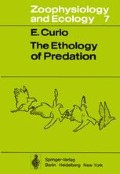Abstract
Predation is an ecological factor of almost universal importance for the biologist who aims at an understanding of the habits and structures of animals. Despite its pervasive nature opinions differ as to what predation really is. So far it has been defined only in negative terms; it is thought not to be parasitism, the other great process by which one organism harms another, nor filter-feeding, carrion-eating, or browsing. Accordingly, one could define predation as a process by which an animal spends some effort to locate a live prey and, in addition, spends another effort to mutilate or kill it. According to this usage of the word a nudibranch, for example, that feeds on hydroids would be a predator inasmuch as it needs some time to locate colonies of its prey which, after being located, scarcely demand more than eating, which differs little from browsing. From the definition just proposed consumption of the prey following its capture has been intentionally omitted. Indeed, an animal may be disposed of without being eaten. Hence the biological significance of predation may be more than to maintain nutritional homeostasis. In fact, predation may have something in common with the more direct forms of competition, a facet that will be only cursorily touched upon in this book. Hence, predation is best distinguished from other forms of foraging by only one of its consequences, in that it concludes with the mutilation or total destruction of an animal that offers some resistance against being discovered and/or being harmed. A parasite may also harm and eventually kill its host but, whereas it is in the interest of the parasite to leave its host alive long enough to complete its life cycle, such need not be the case for a mutilator, as will become clear later on. It is not allimportant to draw such a borderline precisely: the mechanisms underlying the search of an ichneumonid parasite female for eggs of its lepidopteran host may be functionally similar to those of a coccinellid larva in its search for aphids. Therefore, whenever functional similarities seemed to open up new vistas, a broader approach was chosen by amalgating data on search and foraging behavior other than predation in the above sense.
Access this chapter
Tax calculation will be finalised at checkout
Purchases are for personal use only
Preview
Unable to display preview. Download preview PDF.
Author information
Authors and Affiliations
Rights and permissions
Copyright information
© 1976 Springer-Verlag Berlin Heidelberg
About this chapter
Cite this chapter
Curio, E. (1976). Introduction. In: The Ethology of Predation. Zoophysiology and Ecology, vol 7. Springer, Berlin, Heidelberg. https://doi.org/10.1007/978-3-642-81028-2_1
Download citation
DOI: https://doi.org/10.1007/978-3-642-81028-2_1
Publisher Name: Springer, Berlin, Heidelberg
Print ISBN: 978-3-642-81030-5
Online ISBN: 978-3-642-81028-2
eBook Packages: Springer Book Archive

